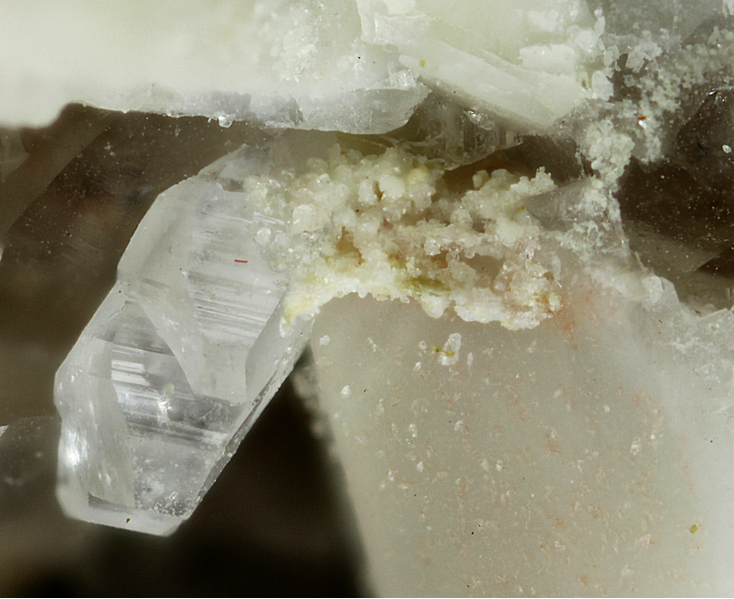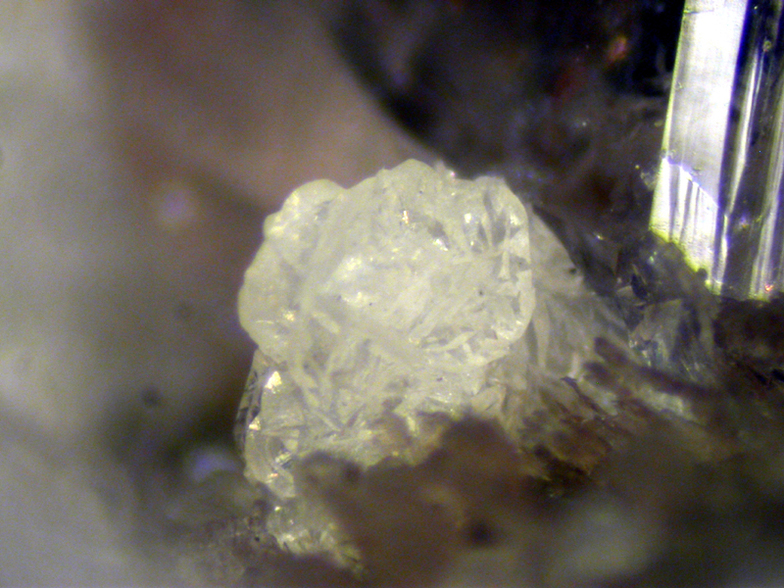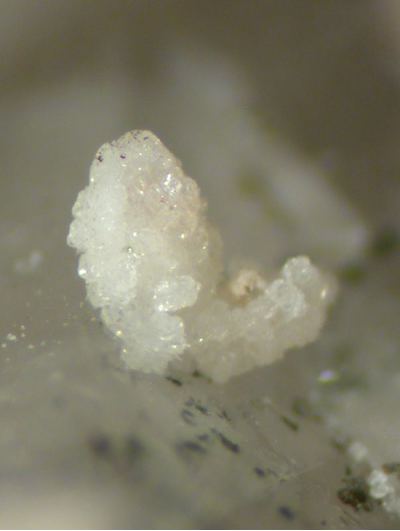Gugiaite
A valid IMA mineral species
This page is currently not sponsored. Click here to sponsor this page.
About Gugiaite
Formula:
Ca2Be[Si2O7]
Colour:
Colourless, yellow
Lustre:
Vitreous
Hardness:
5
Specific Gravity:
3.0336
Crystal System:
Tetragonal
Member of:
Name:
Named for Gujia village, Jiangsu, China, near the type locality.
See also hydroxylgugiaite, related to gugiaite by a complex atomic exchange mechanism coupled with protonation.
Unique Identifiers
Mindat ID:
1769
Long-form identifier:
mindat:1:1:1769:1
GUID
(UUID V4):
(UUID V4):
6bd603a8-51d7-4ba9-b178-4e33c73663a6
IMA Classification of Gugiaite
Approved
IMA Formula:
Ca2BeSi2O7
Approval year:
1983
First published:
1962
Classification of Gugiaite
9.BB.10
9 : SILICATES (Germanates)
B : Sorosilicates
B : Si2O7 groups, without non-tetrahedral anions; cations in tetrahedral [4] and greater coordination
9 : SILICATES (Germanates)
B : Sorosilicates
B : Si2O7 groups, without non-tetrahedral anions; cations in tetrahedral [4] and greater coordination
55.4.2.6
55 : SOROSILICATES Si2O7 Groups,Generally with no Additional Anions
4 : Si2O7 Groups, Generally with No Additional Anions with cations in [8] and lower coordination
55 : SOROSILICATES Si2O7 Groups,Generally with no Additional Anions
4 : Si2O7 Groups, Generally with No Additional Anions with cations in [8] and lower coordination
14.3.8
14 : Silicates not Containing Aluminum
3 : Silicates of Be
14 : Silicates not Containing Aluminum
3 : Silicates of Be
Mineral Symbols
As of 2021 there are now IMA–CNMNC approved mineral symbols (abbreviations) for each mineral species, useful for tables and diagrams.
| Symbol | Source | Reference |
|---|---|---|
| Gug | IMA–CNMNC | Warr, L.N. (2021). IMA–CNMNC approved mineral symbols. Mineralogical Magazine, 85(3), 291-320. doi:10.1180/mgm.2021.43 |
Physical Properties of Gugiaite
Vitreous
Transparency:
Transparent
Colour:
Colourless, yellow
Streak:
White
Hardness:
5 on Mohs scale
Cleavage:
Perfect
Perfect {010}, distinct {001}, poor {110}
Perfect {010}, distinct {001}, poor {110}
Fracture:
Irregular/Uneven
Density:
3.0336(22) g/cm3 (Measured) 3.03 g/cm3 (Calculated)
Comment:
Measured with pycnometer; calculated from optical data gives 3.0628
Optical Data of Gugiaite
Type:
Uniaxial (+)
RI values:
nω = 1.664(1) nε = 1.672(1)
Max Birefringence:
δ = 0.008

Image shows birefringence interference colour range (at 30µm thickness)
and does not take into account mineral colouration.
and does not take into account mineral colouration.
Surface Relief:
Moderate
Chemistry of Gugiaite
Mindat Formula:
Ca2Be[Si2O7]
Elements listed:
Common Impurities:
Ti,Zr,Hf,Al,Fe,Mn,Mg,Na,K,F,Cl,P
Crystallography of Gugiaite
Crystal System:
Tetragonal
Class (H-M):
4 2m - Scalenohedral
Space Group:
P4 2m
Cell Parameters:
a = 7.48(2) Å, c = 5.044(3) Å
Ratio:
a:c = 1 : 0.674
Unit Cell V:
282.21 ų (Calculated from Unit Cell)
Z:
2
Morphology:
{001}, {011}, {111}, {110}
Twinning:
None observed
Crystal Structure
Load
Unit Cell | Unit Cell Packed
2x2x2 | 3x3x3 | 4x4x4
Unit Cell | Unit Cell Packed
2x2x2 | 3x3x3 | 4x4x4
Show
Big Balls | Small Balls | Just Balls | Spacefill
Polyhedra Off | Si Polyhedra | All Polyhedra
Remove metal-metal sticks
Big Balls | Small Balls | Just Balls | Spacefill
Polyhedra Off | Si Polyhedra | All Polyhedra
Remove metal-metal sticks
Display Options
Black Background | White Background
Perspective On | Perspective Off
2D | Stereo | Red-Blue | Red-Cyan
Black Background | White Background
Perspective On | Perspective Off
2D | Stereo | Red-Blue | Red-Cyan
View
CIF File Best | x | y | z | a | b | c
CIF File Best | x | y | z | a | b | c
Rotation
Stop | Start
Stop | Start
Labels
Console Off | On | Grey | Yellow
Console Off | On | Grey | Yellow
Data courtesy of the American Mineralogist Crystal Structure Database. Click on an AMCSD ID to view structure
| ID | Species | Reference | Link | Year | Locality | Pressure (GPa) | Temp (K) |
|---|---|---|---|---|---|---|---|
| 0014911 | Gugiaite | Yang Z, Fleck M, Pertlik F, Tillmanns E, Tao K (2001) The crystal structure of natural gugiaite, Ca2BeSi2O7 Note, z coordinate of Ca is altered to reproduce reported Ca-O bond lengths Neues Jahrbuch fur Mineralogie, Monatshefte 2001 186-192 | 2001 | skarn rocks in the Gugia alkaline complex, Liaoning Province, China | 0 | 293 |
CIF Raw Data - click here to close
X-Ray Powder Diffraction
Powder Diffraction Data:
| d-spacing | Intensity |
|---|---|
| 2.765 Å | (100) |
| 1.709 Å | (70) |
| 1.485 Å | (70) |
| 5.25 Å | (40) |
| 2.97 Å | (40) |
| 2.359 Å | (40) |
| 2.315 Å | (40) |
Comments:
Gugia, China. Data from the type description.
Geological Environment
Paragenetic Mode(s):
| Paragenetic Mode | Earliest Age (Ga) |
|---|---|
| High-𝑇 alteration and/or metamorphism | |
| 31 : Thermally altered carbonate, phosphate, and iron formations | |
| Stage 4b: Highly evolved igneous rocks | >3.0 |
| 34 : Complex granite pegmatites |
Type Occurrence of Gugiaite
General Appearance of Type Material:
Clear tetragonal tablets, mostly 2-3 mm across and 0.3-0.5 mm thick in cavities and disseminated in melanite.
Geological Setting of Type Material:
Skarn zones of alkaline rocks
Associated Minerals at Type Locality:
Reference:
Peng Chi-Jui, Tsao Rung-Lung, and Chou Zu-Rin (1962) Gugiaite, Ca2BeSi2O7, a new beryllium mineral and its relation to the melilite group. Scientia Sinica: 11(7): 977-988.
Synonyms of Gugiaite
Other Language Names for Gugiaite
Relationship of Gugiaite to other Species
Member of:
Other Members of this group:
| Åkermanite | Ca2Mg[Si2O7] | Tet. 4 2m : P4 21m |
| Alumoåkermanite | (CaNa)Al[Si2O7] | Tet. 4 2m : P4 21m |
| Bennesherite | Ba2Fe2+[Si2O7] | Tet. 4 2m : P4 21m |
| Ferri-gehlenite | Ca2Fe3+[AlSiO7] | |
| Gehlenite | Ca2Al[AlSiO7] | Tet. 4 2m : P4 21m |
| Hardystonite | Ca2Zn[Si2O7] | Tet. 4 2m : P4 21m |
| Hydroxylgugiaite | (Ca,◻)2(Si,Be)[(Be,Si)2O5.5(OH)1.5] | Tet. 4 2m : P4 21m |
| Okayamalite | Ca2B[BSiO7] | Tet. 4 2m : P4 21m |
Common Associates
Associated Minerals Based on Photo Data:
| 3 photos of Gugiaite associated with Fluorite | CaF2 |
| 1 photo of Gugiaite associated with Analcime | Na(AlSi2O6) · H2O |
| 1 photo of Gugiaite associated with Aegirine | NaFe3+Si2O6 |
| 1 photo of Gugiaite associated with Aeschynite-(Y) | (Y,Ln,Ca,Th)(Ti,Nb)2(O,OH)6 |
| 1 photo of Gugiaite associated with Chlorite Group | |
| 1 photo of Gugiaite associated with Bavenite | Ca4Be2Al2Si9O26(OH)2 |
| 1 photo of Gugiaite associated with Albite | Na(AlSi3O8) |
Related Minerals - Strunz-mindat Grouping
| 9.BB.10 | Åkermanite | Ca2Mg[Si2O7] |
| 9.BB.10 | Cebollite | Ca5Al2(SiO4)3(OH)4 |
| 9.BB.10 | Gehlenite | Ca2Al[AlSiO7] |
| 9.BB.10 | Hardystonite | Ca2Zn[Si2O7] |
| 9.BB.10 | Jeffreyite | (Ca,Na)2(Be,Al)(Si2O7,HSi2O7) |
| 9.BB.10 | Okayamalite | Ca2B[BSiO7] |
| 9.BB.10 | Ferri-gehlenite | Ca2Fe3+[AlSiO7] |
| 9.BB.10 | Alumoåkermanite | (CaNa)Al[Si2O7] |
| 9.BB.10 | Hydroxylgugiaite | (Ca,◻)2(Si,Be)[(Be,Si)2O5.5(OH)1.5] |
| 9.BB.15 | Barylite | Be2Ba(Si2O7) |
| 9.BB.15 | Barylite-1O | Be2Ba(Si2O7) |
| 9.BB.20 | Andrémeyerite | BaFe2+2(Si2O7) |
| 9.BB.20 | Bennesherite | Ba2Fe2+[Si2O7] |
Other Information
Electrical:
Strongly piezoelectric.
Thermal Behaviour:
Fuses at 950°C with Na2CO3 or NaOH.
Notes:
Soluble in hot HCl, HNO3 and H2SO4 (all 1:1), with separation of some gelatinous silica.
Health Risks:
No information on health risks for this material has been entered into the database. You should always treat mineral specimens with care.
Internet Links for Gugiaite
mindat.org URL:
https://www.mindat.org/min-1769.html
Please feel free to link to this page.
Please feel free to link to this page.
Search Engines:
External Links:
Mineral Dealers:
References for Gugiaite
Reference List:
Localities for Gugiaite
Locality List
 - This locality has map coordinates listed.
- This locality has map coordinates listed.
 - This locality has estimated coordinates.
ⓘ - Click for references and further information on this occurrence.
? - Indicates mineral may be doubtful at this locality.
- This locality has estimated coordinates.
ⓘ - Click for references and further information on this occurrence.
? - Indicates mineral may be doubtful at this locality.
 - Good crystals or important locality for species.
- Good crystals or important locality for species.
 - World class for species or very significant.
(TL) - Type Locality for a valid mineral species.
(FRL) - First Recorded Locality for everything else (eg varieties).
- World class for species or very significant.
(TL) - Type Locality for a valid mineral species.
(FRL) - First Recorded Locality for everything else (eg varieties).
All localities listed without proper references should be considered as questionable.
China (TL) | |
| Peng Chi-Jui et al. (1962) |
Italy | |
| Ciriotti et al. (2021) |
| Ciriotti et al. (2021) | |
| Grill (1935) |
| Pezzotta et al. (1999) | |
Japan | |
| Matsubara (2002) |
Norway | |
| Larsen (2013) |
| Grice et al. (2013) +2 other references |
| Identified on a personally collected specimen (Knut Eldjarn) |
Russia | |
| Tony Nikischer |
Quick NavTopAbout GugiaiteUnique IdentifiersIMA Classification Classification Mineral SymbolsPhysical Properties Optical Data Chemistry Crystallography Crystal StructureX-Ray Powder DiffractionGeological EnvironmentType Occurrence SynonymsOther LanguagesRelationshipsCommon AssociatesStrunz-MindatOther InformationInternet Links References Localities Locality List







 symbol to view information about a locality.
The
symbol to view information about a locality.
The 



Seula mine, Mount Camoscio, Oltrefiume, Baveno, Verbano-Cusio-Ossola Province, Piedmont, Italy